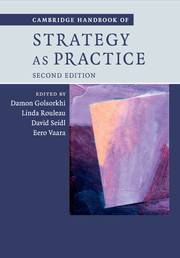Book contents
- Frontmatter
- Contents
- List of figures
- List of tables
- List of boxes
- List of contributors
- Preface to the Second Edition
- Introduction: what is strategy as practice?
- Part I Ontological and Epistemological Questions
- Part II Theoretical Resources: Social Theory
- Part III Theoretical Resources: Organization and Management Theories
- Part IV Methodological Resources
- 24 Using ethnography in strategy-as-practice research
- 25 Researching strategists and their identity in practice: building ‘close-with’ relationships
- 26 Studying strategizing through biographical methods: narratives of practices and life trajectories of practitioners
- 27 Researching everyday practice: the ethnomethodological contribution
- 28 Critical discourse analysis as methodology in strategy-as-practice research
- 29 Studying strategy as practice through historical methods
- 30 Quantitative methods in strategy-as-practice research
- Part V Substantive Topic Areas
- Index
- References
24 - Using ethnography in strategy-as-practice research
from Part IV - Methodological Resources
Published online by Cambridge University Press: 05 October 2015
- Frontmatter
- Contents
- List of figures
- List of tables
- List of boxes
- List of contributors
- Preface to the Second Edition
- Introduction: what is strategy as practice?
- Part I Ontological and Epistemological Questions
- Part II Theoretical Resources: Social Theory
- Part III Theoretical Resources: Organization and Management Theories
- Part IV Methodological Resources
- 24 Using ethnography in strategy-as-practice research
- 25 Researching strategists and their identity in practice: building ‘close-with’ relationships
- 26 Studying strategizing through biographical methods: narratives of practices and life trajectories of practitioners
- 27 Researching everyday practice: the ethnomethodological contribution
- 28 Critical discourse analysis as methodology in strategy-as-practice research
- 29 Studying strategy as practice through historical methods
- 30 Quantitative methods in strategy-as-practice research
- Part V Substantive Topic Areas
- Index
- References
Summary
Introduction
When we think of ethnography we surely go back to those classic organizational ethnographies, which generated rich, in-depth and fascinating insights into various aspects of organizational life: Elton Mayo's famous Hawthorne studies (Roethlisberger and Dickson 1956); Melville Dalton's (1959) study of power and politics in management, which he observed while working as a manager in a US factory; Elliot Jacques’ (1951) collaborative field study of worker and management relationships, with a research team of eight people at the UK Glacier Metal Company; Trist and Bamforth's (1951) two-year study of the longwall coal mining method technology, social organization, work conditions and group processes (Bamforth himself had been a miner); Walker and Guest's (1952) study of assembly line work; and W. F. Whyte's (1948) study of interactions and work practices in a Chicago restaurant.
More recently, who can forget that John Van Maanen's (1991) study of Disneyland's organization culture and work practices ended when he was fired for a ‘Mickey Mouse offense’ (his hair was too long) after three years working as a ride operator? Or the subtle challenge to the control and authority of a director in Tony Watson's (1994) ethnography of management in a UK plant, as executives rearranged their seating so that the director was unable to sit in his ‘normal’ seat? And Bud Goodall's (2005) poignant comment in his narrative ethnography of his discovery that his father, unknown to Bud, had been a CIA agent: ‘A narrative inheritance touches everything, one way or another, in our lives’ (Goodall 2005: 503). He also makes the observation that stories from the past not only help us explain stories of the present but that embedded in such stories are dialectical tensions of identity, relationships and culture.
Such rich stories and detailed observations are the stuff of ethnography. ‘Ethnographers describe, principally in writing, how the people of some place and time perceive the world and how they act in it’ (Ingold 2008: 90), and they do so on the basis of prolonged immersion in a research site, getting to know people and how they live their lives.
- Type
- Chapter
- Information
- Cambridge Handbook of Strategy as Practice , pp. 431 - 446Publisher: Cambridge University PressPrint publication year: 2015
References
- 6
- Cited by

